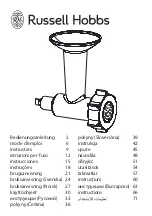
9
EN: FRUITS AND VEGETABLES DEHYDRATOR |
Instruction Manual
arrange the bars. Replace the lid. Set a temperature of 50-70° C and turn on the dryer for 6-10 hours or overnight.
Use as many trays as needed.
RECOMMENDATIONS FOR VEGETABLES DEHYDRATION
Dried vegetables can be added to soups, stews, casseroles, and more.
Rinse the vegetables with cold water before preparation and dehydration. Then clean and, if necessary, cut the selected
products.
Find out the needed dehydration time in the table at these instructions end.
The best way for vegetables pre-treatment is to steam. Place a layer of cut or chopped vegetables in a colander or on the
steamer rack. The vegetables layer may be up to 2-3 cm high. Place the colander or griddle in the steamer or a pre-filled with
water saucepan with steamer basket. The water should not touch the vegetables. At the end of pre-treatment the vegetables
should be soft. Arrange the ready vegetables in the dehydrator sections and start drying.
We recommend to blanch the green beans, cauliflower, broccoli, asparagus, potatoes, and green peas. Since these vegetables
are often used in soups and stews, blanching will help preserve their natural color. Put the vegetables in a saucepan with
boiling water for 3-5 minutes. Then pour out the water and shake off the remaining water from the vegetables. Distribute the
vegetables in the dehydrator sections.
Note that although blanching products takes less time than steaming, many nutrients are lost during the process. It is not
recommended to blanch fine chopped vegetables that can be overcooked during blanching. The best is to blanch vegetables
cut into slices. Do not put more than one cup of vegetables per liter of water. Start counting down the time once you have
put the vegetables in the boiling water. The blanching time is, for example, from one third to one half of the time required for
steaming.
Vegetable chips
Choose vegetables such as: cucumbers, aubergines, zucchini or parsnips. Cut into thin slices approximately 3 mm thick
and steam for 5 minutes. Then finely salt the slices, but you may use mix of salt and spices to get a more interesting flavor.
Dehydrate the chips until they become crispy. Vegetable chips can be served separately or with cream or sauce.
Powdered vegetables.
You can make a vegetable puree, dry it, for example as pestil, and then turn it into powder so that you can later add it to
juices, soups, sauces or baby food. Dehydrate the vegetable puree until it becomes very crispy, then immediately grind it
in a blender. Grind small amounts of dehydrated puree at one time. Powdered vegetables must be stored in tightly closed
containers, otherwise the powder may granulate.
If necessary, blanch or steam the vegetables before dehydrating.
When using such powder, keep in mind that it is very concentrated, so it should be added to food in small quantities, until the
dish gets the desired taste and aroma.
RECOMMENDATIONS FOR MEAT DEHYDRATION
Preparation of meat and game for drying
For efficient drying, choose lean meats without fat.
Before drying, the meat should be marinated for extra flavor and make it more tender. The marinade must contain salt, which
helps to extract excess moisture from the meat and thus increase its shelf life. The marinade must not contain any vegetable
oil. In most cases, the marinade includes some acid (for example, tomato sauce or vinegar ) because the acid destroys the
fibers of the meat and makes it more tender.
To obtain very thin pieces, it is recommended to cut partially frozen meat.
If you dry meat or game for stewed dishes, soups, and similar dishes, be sure to cook it before dehydration. Cut the finished
meat into small cubes and place in the dehydrator section. Dry until all the moisture evaporates - this may take 2 to 8 hours.
When it is necessary to add dried meat to a dish, first recover it by putting in water or in broth for half or more hours. The










































